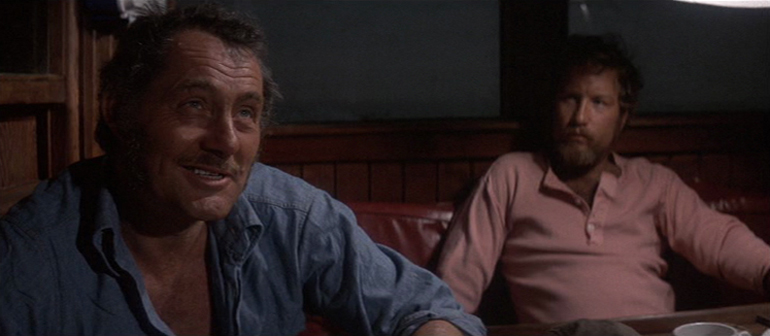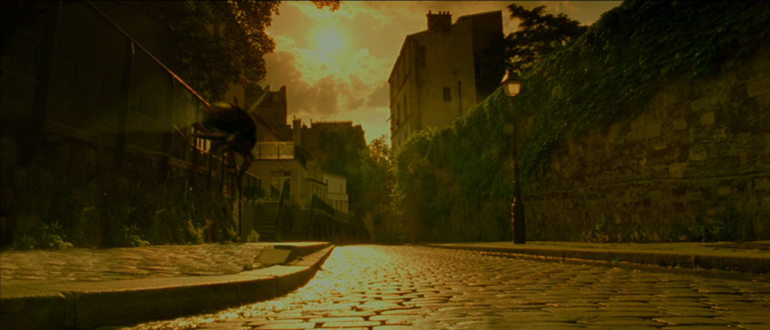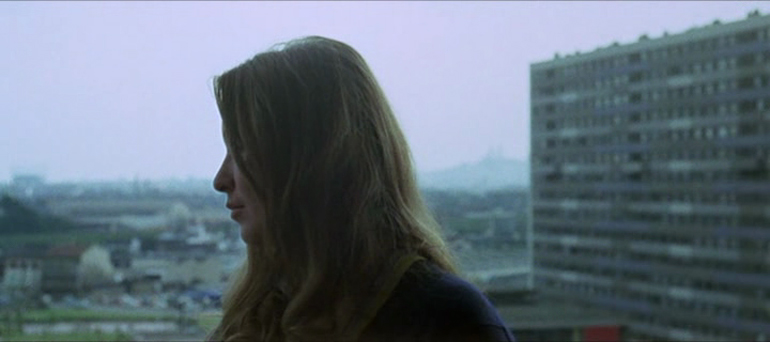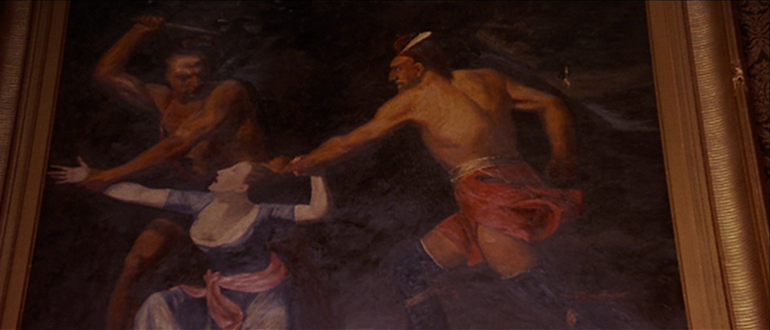FURTHER REMARKS ON SHOWING AND TELLING
Sarah Kozloff
 FORWARD
FORWARD
 DOWNLOAD
DOWNLOAD
 ABSTRACT / KEYWORDS / ARTICLE / BIBLIOGRAPHY / ABOUT THE AUTHOR
ABSTRACT / KEYWORDS / ARTICLE / BIBLIOGRAPHY / ABOUT THE AUTHOR
In Invisible Storytellers (1988) I spent a few pages discussing the source of one of the influential prejudices against voice-over narration: the preference by critics for “showing” over “telling.” Since this dogma still circulates widely, I’d like to return to this subject. The terms “showing” and “telling” have infiltrated numerous fields, thus, these comments will touch on words and images; literary theory and narrative theory; contemporary popular advice concerning creative writing; both documentary and fiction films; and both on-screen dialogue and the main subject at hand—cinematic voice-over narration.
One of the main differences between 19th century novelists such as Tolstoy, Thackeray, and George Eliot, and early 20th century writers is that the former would include exposition and commentary. Take, for instance, the opening line of Anna Karenina: “Happy families are all alike; every unhappy family is unhappy in its own way”. Modernist authors, by contrast, present their stories without such guidance, more “scenically”, as in the first sentence of Hemingway’s The Big Two-Hearted River: “The train went on up the track out of sight around one of the hills of burnt timber”. Tempting though it may be to ascribe this change to the birth of the cinema, in actuality the change in narrative technique predates the Lumières; in the 1850s Flaubert famously banished the artist’s voice from his creation, and his follower, Guy de Maupassant, who passed away in 1893, epitomizes this scenic style.
Percy Lubbock, a British author, scholar, and close friend of Henry James, published The Craft of Fiction in 1921. In this study he differentiates between two uses of point of view: “In one case the reader faces towards the story-teller and listens to him, in the other he turns towards the story and watches it”. Lubbock favors the second choice: “The scene he evokes is contemporaneous, and there it is, we can see it as well as he can. Certainly he is ‘telling’ us things, but these are things so immediate, so perceptible that the machinery of his telling by which they reach us, is unnoticed; the story appears to tell itself” (1921: 111, 113).
Lubbock’s analysis of formal choices was soon echoed by other critics and hardened into prescription. Ford Madox Ford pronounced that the novelist has “to render and not to tell” (1930: 122). In the inaugural edition of the American literary journal The Southern Review in 1935, Ford wrote:
“But already by the age of Flaubert, the novelist had become uneasily aware that if the author is perpetually, with his reflections, distracting his reader’s attention from the story, the story must lose interest. Some one noted that in Vanity Fair when Mr. Thackeray had gradually built up a state of breathless interest and Becky Sharp on the eve of Waterloo had seemed almost audibly to breathe and palpitate before your eyes, suddenly the whole illusion went to pieces. You were back in your study before the fire reading a book of made-up stuff” (Ford, 1930: 22-23)
By 1950 a collection of short stories with commentaries, The House Of Fiction, advocates “the direct impression of life”. The scholars legislate:
“The author’s legitimate authority lies not in his telling us that the scene is such, that these people did a certain thing, that what they did meant this or that; it lies rather in convincing us that the scene, the characters, the meaning, all move together in a dynamic pattern that we can believe in apart from the author’s personality” (Gordon and Tate, 1950: 621)
Reacting against the critical dogma of the 1950s, the American scholar Wayne Booth published The Rhetoric of Fiction in 1961. Booth felt that what had begun as description of authorial choices had morphed into prescriptive dogma that devalued the great 18th and 19th century novelists. Crucially, Booth also raised the question of ethics, pondering whether hiding the authorial hand or judgment might lead to moral quandaries.
The Rhetoric of Fiction had an immense effect on literary scholars and on the burgeoning field of narrative theory. Gérard Genette noted in 1972 that the followers of Flaubert and Hemingway believe in “making one forget that is it the narrator telling”. However, Genette remarks, “‘Showing’ can be only a way of telling, and this way consist both saying about it as much as one can, and saying this ‘much’ as little as possible”. Genette’s English translator helpfully includes the original French: “en dire le plus possible, et ce plus, le dire le moins possible” (1972: 166). In recent decades narratology has replaced “showing” versus “telling” with more precise terminology, such as “overt” versus “covert” narration, or “mimetic” versus “diegetic” narration. In general, however, narrative theorists place no value judgment on these choices, allowing each artist his or her own methods to suit the aims or the text (Rabinowitz, 2005).
But prescriptive advice persists in creative writing classes and in popular discourse. Typing “Show, don’t tell” into Google yields half a million hits in 2013. Take, for example, a recent article written to aspiring writers by Noah Lukeman, for the journal The Writer. Lukeman, a literary agent and former editor, counsels:
“A writer can stop and tell us everything about a character, but eventually it will become meaningless, just a litany of facts, no better than an encyclopedia or dictionary. It is the writer’s job to show us what his characters are like, not by what he says about them, or about what they say about each other but by their actions” (Lukeman, 1999: 9)
Similarly, the popular blogger Grammar Girl proclaims: “Good writing tends to draw an image in the reader’s mind instead of just telling the reader what to think or believe” (2010).
So this dogma still influences popular perception. Moreover, I believe that privileging covert rather than overt narration lies behind much of filmmakers’ lingering hesitation to use voice-over and critics and viewers knee-jerk harsh judgment of voice-over whenever it is employed. I am the only person I know who prefers the 1982 studio version of Blade Runner (Ridley Scott) with Deckard’s neo-noir voice-over, to the 1993 director’s cut in which Scott removes it. A reviewer on Amazon.com unequivocally decrees that the director’s cut is vastly preferable because it has eliminated “the ludicrous and redundant voice-over narration”.
The prescriptive advocacy of showing over telling is entangled with several endlessly asserted presuppositions about authors, stories, and receivers (literary or cinematic, nonfiction or fiction). Let me try to untangle some of these presuppositions.
Presupposition 1) Narratives should be transparent, keeping their narrator covert because,
Presupposition 2) Narratives must engage the reader/viewer throughout the text, never allowing the audience to focus on the teller or the telling of the tale.
Studying the emotional effect of narratives, the psychologists Melanie Green, Timothy C. Brock, and Geoff Kaufman offer a nice phrase for our immersion in a fictional world: they say that readers are “transported”. They argue, “One key element of an enjoyable media experience is that it takes individuals away from their mundane reality and into a story world” (2004: 311). This metaphor become literal in the policy short that the American theater chain Regal Cinema plays before each feature film, instructing the audience members to turn off their cell phones and keep quiet during the show. The trailer invites viewers to take a ride on a magic, futuristic monorail, a vehicle that is going to take us to fantastical places.

Presumably, if a narrator “tells” us information, becomes overt instead of covert, we will feel rudely knocked off this magic transportation device and all our pleasure in escaping our own humdrum existence will be spoiled.
While Classical Hollywood narrative often —though not always— strives for a seamless transparency, we know that this is only one (influential) style of filmmaking, not the only choice. In Alain Resnais’ My American Uncle (Mon oncle d’Amérique, 1980) Prof. Henri Laborit’s voice-over narration continually reminds us that the characters are nothing more than lab mice reacting to the stress of their environment. Our engagement in their stories is forcibly disrupted, but we engage with the film on another level: considering the professor’s behaviorist theories, wondering how much they apply to our own lives.
Resnais, of course, belongs to a certain time period in European art cinema, a stretch where filmmakers habitually broke away from linear narratives to explore new narrative devices. However the popularity of Pulp Fiction (Quentin Tarantino, 1994), Run Lola Run (Lola rennt, Tom Tykwer, 1998), Memento (Christopher Nolan, 2000), or Pan’s Labyrinth (El laberinto del fauno, Guillermo del Toro, 2006) demonstrates that experimenting with narrative form —making us focus on narrative discourse just as much as (or more) than the story— still intrigues viewers.
Presupposition 3) Showing is more vivid, expressive, and powerful than telling. In short, telling is boring.
Really? As I detail in Overhearing Film Dialogue, one of the unrivaled benefits that speech adds to films is the possibility of scenes of oral storytelling. The clip I often study with my students from the Argentine film The Official Story (La historia oficial, Luis Puenzo, 1985) is the scene where Ana tells Alicia about her ordeal when she was kidnapped and tortured by the military junta. The camera focuses in close-ups and two-shots on Ana as she tells her childhood friend about her trauma. Moviegoers see the effect of the story on Alicia: how Alicia moves from drunken silliness, to empathy and horror, to resisting the full ramifications of Ana’s story.
By the same token, none of Captain Quint’s actions in Jaws (Steven Spielberg, 1975), and none of Spielberg’s shots of him, come close to revealing his character as the scene when he tells the story of what happened to him during WWII on the U. S. S. Indianapolis. During this storytelling scene, nothing happens visually, all of the action lies in the words:
“Japanese submarine slammed two torpedoes into her side, Chief. We was comin' back from the island of Tinian to Leyte ... just delivered the bomb. The Hiroshima bomb. Eleven hundred men went into the water. Vessel went down in 12 minutes. Didn't see the first shark for about a half an hour. Tiger. 13-footer. You know, you know that when you're in the water, Chief? You tell by looking from the dorsal to the tail.
What we didn't know was our bomb mission had been so secret, no distress signal had been sent. They didn't even list us overdue for a week.
Very first light, Chief, sharks come cruisin', so we formed ourselves into tight groups. You know, [music starts] it was kinda like old squares in the battle like you see in the calendar named "The Battle of Waterloo" and the idea was: shark comes to the nearest man, that man he starts poundin' and hollerin' and screamin' and sometimes the shark go away ... sometimes he wouldn't go away. Sometimes that shark he looks right into ya. Right into your eyes. You know, the thing about a shark ... he's got lifeless eyes. Black eyes. Like a doll's eyes. When he comes at ya, doesn't seem to be living ... until he bites ya, and those black eyes roll over white and then ... ah then you hear that terrible high-pitched screamin'. The ocean turns red, and despite all the poundin' and the hollerin', they all come in and they ... rip you to pieces.
Know by the end of that first dawn, lost a hundred men. I don't know how many sharks, maybe a thousand. I know how many men; they averaged six an hour. On Thursday morning, Chief, I bumped into a friend of mine, Herbie Robinson from Cleveland. Baseball player. Boatswain's mate. I thought he was asleep. I reached over to wake him up. He bobbed up and down in the water just like a kinda top. Upended. Well, he'd been bitten in half below the waist.
Noon, the fifth day, Mr. Hooper, a Lockheed Ventura saw us. He swung in low and he saw us ... he was a young pilot, a lot younger than Mr. Hooper. Anyway, he saw us and he come in low and three hours later a big fat PBY comes down and start to pick us up. You know that was the time I was most frightened ... waitin' for my turn. I'll never put on a lifejacket again.
So, eleven hundred men went in the water; 316 men come out and the sharks took the rest: June the 29th, 1945. Anyway, we delivered the bomb”
Quint’s story mixes vivid, visual detail (sharks have black, doll’s eyes; Herbie Robinson bobbed in the water like a top); expository information (the mission was so secret that no distress symbol had been sent); references to the on-screen listeners (the pilot was younger than Mr. Hooper); and revelation of the storyteller’s feelings (Quint was most frightened waiting for his turn to be rescued). And while Robert Shaw is telling the story, the camera shows his face, and the faces of those listening to him. Viewers study this beaten face with its embarrassed half-smile while he tells this horrifying tale. We don’t need to see the sharks in the water; we see them more vividly in our minds’ eye than any special effects team could replicate.
Far from being less vivid than pictures, words can —in fact— be far more specific. Images, unanchored by identifying words, float away. Visitors to a photography exhibit always read the captions on the walls; only by incorporating the information as to date and place do we feel that we can process the pictures. Filmmakers habitually shoot wherever their budgets allow because they know that Canadian pastures can substitute for the Great Plains, Vancouver can be New York, or The Philippines can become Vietnam, just through a verbal mention.
The opening of Amélie (Le Fabuleux Destin d’Amélie Poulain, Jean-Pierre Jeunet, 2001) illustrates words’ ability to be more precise than images:
“On September 3rd 1973, at 6:28 p.m. and 32 seconds, a bluebottle fly capable of 14,670 wing beats a minute landed on Rue St. Vincent, Montmartre. At the same moment, on a restaurant terrace nearby, the wind magically made two glasses dance unseen on a tablecloth. Meanwhile, in a 5th-floor flat, 28 Avenue Trudaine, Paris 9, returning from his best friend’s funeral, Eugène Colère erased his name from his address book. At the same moment, a sperm with one X chromosome, belonging to Raphael Poulain, made a dash for an egg in his wife Amandine. Nine months later, Amélie Poulain was born”
The images show a fly; two glasses on a white tablecloth that is fluttering in the wind; a sighing man erasing a name in an address book; and outdated filmstrips of sperm; a pregnant woman; and a baby being born. However, all the specific, expressive details that anchor the imprecise visuals —the date, the places, these events’ simultaneity, how fast the fly’s wings move, the fact that the man is returning from a funeral of his best friend, that the baby is the Amélie of the film’s title— come from the voice-over narration. The voice-over establishes the film’s wry irony through its postmodern bricolage of scientific arcana, insight into emotional states, and self-consciousness. In terms of artistry, while the shot shows us the table and the glasses, only the voice-over is able to transmute that moment into a simile of the glasses dancing unseen by anyone in the fictional world, but noticed by the narrator.
Presupposition 4) Showing is more subtle than telling. Telling is less artistic because it is too crude, too bald.
I’m not convinced that subtlety is the apotheosis of all art. Surely we treasure some artistic works for their clarity and explicitness: The Battleship Potemkin (Bronenosets Potiemkin, Sergei Eisenstein, 1925), for instance, is hardly subtle, nor Hitchcock’s Psycho (1960), Costa-Gavras’ Z (1969), or Hooper’s Les Misérables (2012). Explicit voice-over narration doesn’t automatically deserve scorn; sometimes such straightforward rhetoric effectively connects the viewers to the material or characters.
Secondly, as Invisible Storytellers took pains to illustrate, as a cinematic tool voice-over narration can indeed be ambiguous, ironic, and bewitching. As soon as filmmakers add a narration track they create congruency and/or conflict with the visual track. How are we supposed to understand the very flat commentary of Buñuel’s Land Without Bread (Las Hurdes, tierra sin pan, 1933)? Why does William Wyler use two different narrators for The Memphis Belle (1945)? How reliable is Henry Hill (Ray Liotta) as the first-person narrator of Scorsese’s Goodfellas (1990)?
In the opening of Two or Three Things that I Know about Her (2 ou 3 choses je sais d’elle, 1967) Godard illustrates that even seemingly “redundant” voice-over is anything but. Over a shot of an attractive young woman on an apartment balcony he whispers:
“She is Marina Vlady. She is an actress. She’s wearing a midnight-blue sweater with two yellow stripes. She is of the Russian origin. She has dark chestnut or light brown hair. I’m not sure which”.
After Vlady speaks directly to the camera, quoting Brecht, Godard repeats this information with slight changes:
“She is Juliette Janson. She lives here. She’s wearing a midnight-blue sweater with two yellow stripes. She has dark chestnut or light brown hair. I’m not sure which. She’s of Russian origin”.
What are we to make of these whispers? The crucial difference between these two introductions is that Godard is moving us from the actress to the character, but our suspension of disbelief in the “reality” of Juliette is forever compromised. Even more compromised is our belief in the omniscience of the narrator; he can’t even decide what color her hair is. But most importantly, in this opening movie-goers become totally unsettled as to our own competence in decoding a text: after the first introduction, Vlady turns her head, and the voice-over whispers: “Now she turns her head to the right, but that means nothing”. After the second introduction, Juliette also turns her head, and Godard tells us, “Now she turns her head to the left, but that means nothing”. The colors of her sweater and hair (which we can see for ourselves) matter so that he mentions them twice, but we are explicitly told that her movements are meaningless. Which details in a film are significant and which aren’t? This redundant voice-over has immediately put our customary viewing habits up for grabs.
Less radical, but equally intriguing, the voice-over narrator of Scorsese’s The Age of Innocence (1994) works with the camera to comment on the mores of the wealthy upper class New Yorkers of the 1870s. For example, while visiting Mrs. Manson Mingott’s house the narrator placidly remarks:
“For now, she [Mrs. Mingott] was content simply for life and fashion to flow northwards to her door and to anticipate eagerly the union of Newland Archer with her grand-daughter, May. In them, two of New York’s best families would finally and momentously be joined”
Meanwhile, the camera wanders up the staircase surveying the paintings hung there, ending on a picture of two savage Indians scalping a white woman. Smug, self-satisfied, immensely wealthy and so over-weight that she can barely move, Mrs. Mingott and her set’s domination have been built on —or still entail?— a rapacious violence, a violence that they secretly relish.
Jean-Luc Godard, Terrence Malick, Martin Scorsese and others habitually enrich their films with voice-over speech, adding extra dimensions. But intriguing voice-over is not confined to respected high art auteurs. In another venue (2012) I examined a spate of contemporary British and American romantic comedies, including Clueless (Amy Heckerling, 1995), High Fidelity (Stephen Fears, 2000), Bridget Jone’s Diary (Sharon Maguire, 2001), About a Boy (Chris Weitz and Paul Weitz, 2002), Eternal Sunshine of the Spotless Mind (Michel Gondry, 2004), Hitch (Andy Tennant, 2005), Waitress (Adrienne Shelly, 2007) and 500 Days of Summer (Marc Webb, 2009). All of these enhance their stories by incorporating voice-over narration —first person or third— sometimes to forge a more intimate connection between filmgoer and character and sometimes ironically.
Presupposition 5) Showing allows for more ambiguity and involvement than telling, thus—
Presupposition 6) Showing is more democratic, while telling is more autocratic.
I’m not at all sure that cinematic showing —i.e. presenting action without expository captions or voice-over— necessarily entails ambiguity. As Tom Gunning carefully argues in “Narrative Discourse and the Narrator System”, everything that is carefully placed in front of the camera, just as carefully photographed in a certain way, and deliberated edited into the final cut serves to narrate information to the viewer. Character X’s face (so carefully lit, and using all the actress’s skill) narrates that her feelings were hurt by the comment of Character Y. Character Z’s close-up indicates that he is pondering his next move, or remembering something that happened earlier. Character A’s POV shot shows that he notices that his antagonists are cutting off his escape route. From an omniscient bird’s eye view, we the viewers see what the characters don’t see: that the monstrous wave/runaway train/prehistoric monster is just about to descend upon the unsuspecting innocents. In every case the film conveys narrative information just as surely as if a chatty literary narrator spoke aloud. The clarity of the Hollywood style is why David Bordwell describes it as an “excessively obvious” cinema.
For example, when, at the end of High Noon (Fred Zinemann, 1952), Will Kane (Gary Cooper) throws his sheriff’s badge down in the dust in disgust, viewers understand: removing badge = renouncing position; throwing in dust = disgust at the townspeople’s cowardice and refusal to help him fight the Frank Miller gang. Viewers really don’t have the choice to idly entertain alternate explanations, such as that the badge pin was sticking into Will’s skin, or that he still loves the people of Hadleyville.
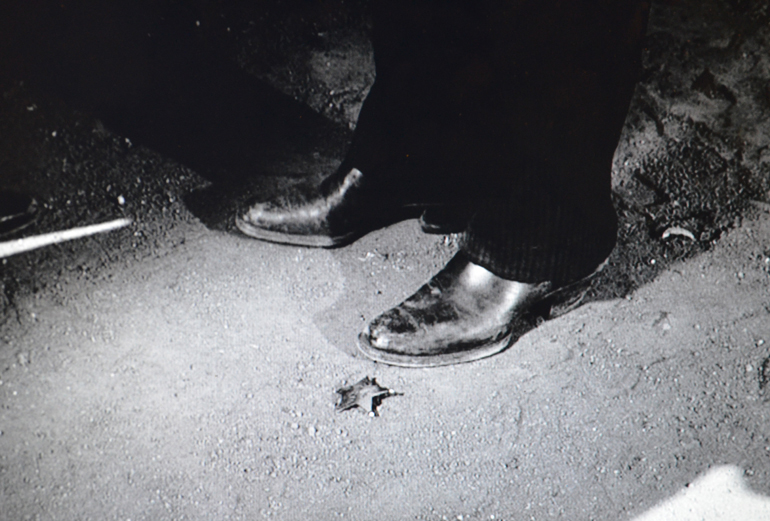
And this sort of obvious connect-the-dots visual narration occurs in other national cinemas too: in Strike (Stachka, Sergei Eisenstein, 1925) when Eisenstein cuts from police killing workers to an ox being slaughtered viewers are not free to interpret this montage as showing the factory owner preparing a bountiful feast for his cherished employees.
Moreover, despite André Bazin’s arguments about how in contrast to editing, deep focus/deep space allow for democracy and ambiguity, even shots manifesting deep focus guide viewers to the conclusion that the filmmakers desire. Take, for instance, the famous shot from Citizen Kane (Orson Welles, 1941) showing that Susan Alexander Kane has tried to commit suicide. No narrator says aloud: “Susan tried to kill herself”, but viewers are hardly free to ponder other possibilities, such as that Susan might be drunk, sick, or just ignoring Kane at the door. Viewers have no choice but to add up the visual elements: glass + spoon + medicine bottle + Susan in darkness with labored breathing + unresponsiveness to loud calling and door knocking = suicide attempt.
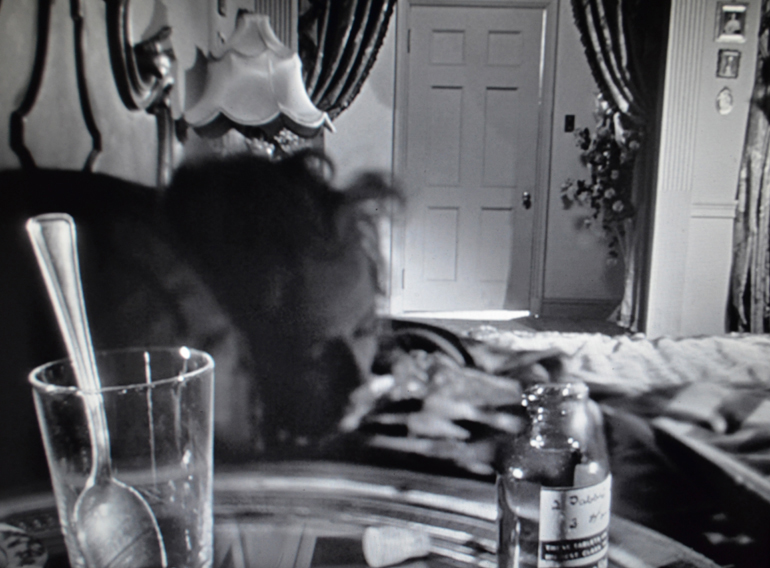
Even if showing sometimes may be less directive than overt narration in conveying expository information or making commentary on events (many shots and scenes in Antonioni’s L’avventura [1960] don’t carry the narrative forward but instead create ambiguity or dwell on the sensuous appeal of the physical world), is ambiguity always and in every instance a virtue? Stanley Kubrick forcefully asserts, “The essence of dramatic form is to let an idea come over people without its being plainly stated. When you say something directly, it is simply not as potent as it is when you allow people to discover for themselves” (Kubrick in Schickel, 2001: 160). But Kubrick and others offer no proof of this common presupposition. Certainly in Kubrick’s case his penchant towards ambiguity has led to his high esteem in art cinema circles, but equal misgivings about the ethics of films such as A Clockwork Orange (1971).
Since the rise of direct cinema in documentary many non-fiction filmmakers have felt that they need to withhold the research they have conducted or their own judgments. Hundreds of documentaries include only interviews, archival footage, location sound, and B roll. Yet as theorists such as Bill Nichols have demonstrated, all of these choices add up to convey the film’s ideology just as surely as any narration might. If we are judging showing versus telling on the basis of ethics and ideology one could easily make the argument that hiding one’s opinions is less ethical than stating them directly. Is pretending to objectivity more ethical than owning one’s stance?
The obverse of democratic is “autocratic.” Certainly the narrators of nineteenth-century novels inserted explicit social commentary into their stories. Overt narration now carries an autocratic, authoritarian taint. Many critics criticize narrators who address the reader or the viewer directly as “telling us what to think”. Richard Leacock, a major documentarian of the direct cinema movement active in the 1960s once told an interviewer: “The moment I sense that I’m being told the answer I start rejecting”.
Rejecting voice-over has thus become entangled with revolt against Victorian certainties; rejecting this cinematic technique is somehow now tied in with modernist and post-modernist rejection of master narratives such as faith in progress, respect for authority, belief in religion. In many minds all narrative commentary connotes either a hectoring schoolmarm or a pompous “voice of God”, both of whom are tyrannical despots trying to restrict viewers’ freedom.
The continued use of the term “voice of God” merits two comments. First, typifying voice-over narrators as godly and omniscient often ignores the evidence of the actual films. In the 1930s, Westbrook Van Voorhis, the narrator of the March of Time newsreel, spoke with great authority, brooking no demur: nowadays his commentary sounds grating if not laughably preposterous. But many of the narrators of World War II documentaries who are now dismissed for their alleged pomposity and omniscience in actuality were much more tentative, measured, and ironic than is generally remembered. Charles Woolf sensitively analyzes The Spanish Earth (Joris Ivens, 1937) and The Battle of Midway (John Ford, 1942). Diary for Timothy (Humphrey Jennings, 1945) uses multiple, quiet voices. Even Prelude to War (Frank Capra and Anatole Litvak, 1942), the American propaganda film that is part of the Why We Fight (1942-1945) series produced by Frank Capra, employs a narrative track (spoken by Walter Huston in a quiet, rather scratchy voice), that is more deadpan and ironic than godly.
The resistance to telling, to an omniscient narrator (or any narrator) seems part of the post-modern rejection of “god”: that is, all claims of authority and omniscience.
I had hoped that examples of the complexity and variety of voice-over —How Green Was My Valley (John Ford, 1941), The Naked City (Jules Dassin, 1948), All About Eve (Joseph L. Makiewicz, 1950), and Barry Lyndon (Stanley Kubrick, 1975)— might prompt a re-evaluation of this rhetorical device. However, widespread axioms, deeply imbricated with the sweep of history and culture, are not easily dislodged.
Nonetheless, I am cheered by the fact that some contemporary popular discourse demonstrates a more nuanced appreciation for narration than the command, “show, don’t tell”, alone would indicate. For example, the title of a contemporary article in the British newspaper The Telegraph, “Do Voice-Overs Ruin Films?”, would lead one to believe that the writer, Anne Billson, disdains voice-over. She does, indeed, despise its use in Luhrmann’s The Great Gatsby (2013) and Blade Runner, but the bulk of her piece presents an appreciation of how much voice-over adds to other films, such as the noirs of the forties or Apocalypse Now (Francis Ford Coppola, 1979).
When I wrote Invisible Storytellers, home video had just been invented. To see many of the films discussed I had to travel to archives to screen 16 mm prints on flatbed editing machines. The explosion in availability now makes international film history available worldwide at the click of one’s mouse. Case by case analysis, rather than axiomatic dismissal and asserted presuppositions may gradually win out. Time will tell.
ABSTRACT
This essay examines the endurance of popular prescriptions that stories should “show, don’t tell”. It traces this dogma back to early 20th century literary theorists. Then the essay untangles the presuppositions that underlie this axiom, and refutes them, especially as pertains to the use of voice-over narration in the cinema.
KEYWORDS
Voice-over narration, showing vs. telling, overt narration, covert narration.
BIBLIOGRAPHY
AMAZON.COM, “Editorial Reviews: Blade Runner (The Director’s Cut). http://www.amazon.com/Blade-Runner-The-Directors-Cut/dp/0790729628
BAZIN, André (2011). “Evolution of the Language of the Cinema” in Critical Visions in Film Theory. Ed. Corrigan, Tim, White, Patricia, Mazaj, Meta. New York: Bedford/St, Martins.
BILLSON, Anne. (2013). “Do Voice-Overs Ruin Films?” The Telegraph. http://www.telegraph.co.uk/culture/film/10078663/Do-voice-overs-ruin-films.html
BLUE, James (1965). “One Man's Truth: An Interview with Richard Leacock,” Film Comment 3: 15-23.
BOOTH, Wayne C. (1961). The Rhetoric of Fiction. Chicago: University of Chicago Press.
FOGARTY, Mignon. Grammar Girl. “Show, Don’t Tell,” 28 October 2010. http://www.quickanddirtytips.com/education/grammar/show-don-t-tell#sthash.Nxbdj6Zl.dpuf
FORD, Madox Ford (1930). The English Novel: From the Earliest Days to the Death of Joseph Conrad. London: Constable.
FORD, Madox Ford (1935). “Techniques,” The Southern Review (July) 20-35.
GENETTE, Gérard (1980). Narrative Discourse: An Essay in Method, trans. Jane E. Lewin. Ithaca: NY: Cornell University Press.
GORDON, Caroline and TATE, Allen (1950). The House of Fiction: An Anthology of the Short Story with Commentary. New York: Charles Scribner’s Sons.
GREEN, Melanie C., BROCK, Timothy C and KAUFMAN, Geoff (2004). “Understanding Media Enjoyment: The Role of Transportation into Narrative Worlds,” Communication Theory 14:4: 311-327.
GUNNING, Tom (1999). “Narrative Discourse and the Narrator System,” in Film Theory and Criticism: Introductory Readings, 5th Ed, BRAUDY, Leo and COHEN, Marshall (New York: Oxford University Press): 461-472.
KOZLOFF, Sarah (1988). Invisible Storytellers: Voice-Over Narration in American Fiction Films. Berkeley: University of California Press.
KOZLOFF, Sarah (2000). Overhearing Film Dialogue. Berkeley: University of California Press.
KOZLOFF, Sarah (2012). “About a Clueless Boy and Girl: Voice-Over in Romantic Comedy Today,” Cinephile 8:1 5-13.
LUBBOCK, Percy (1957). The Craft of Fiction. London: Jonathan Cape.
LUKEMAN, Noah (1999). “Showing versus Telling,” The Writer 112 (7): 9-12.
NICHOLS, Bill (1991). Representing Reality. Bloomington: Indiana University Press.
SCHICKEL, Richard (2001). “Kubrick’s Greatest Gamble: Barry Lyndon.” In PHILLIPS, Gene D. ed. Stanley Kubrick: Interviews. Jackson, Mississippi: University Press of Mississippi.
RABINOWITZ, Peter (2005). “Showing Vs. Telling,” Routledge Encyclopedia of Narrative Theory, ed. HERMAN, David, JAHN, Manfred and RYAN, Marie-Laure. New York: Routledge. 530-1.
WOLFE, Charles (1997). “Historicizing the 'Voice of God': The Place of Vocal Narration in Classical Documentary,” Film History, 9:2: 149-167.
SARAH KOZLOFF
Sarah Kozloff is the William R. Kenan, Jr. Professor of Film at Vassar College in Poughkeepsie, New York. She is the author of Invisible Storytellers: Voice-Over Narration in American Fiction Films (1988) and Overhearing Film Dialogue (2000), along with numerous other pieces on film sound, narrative theory and genre.
Nº 3 WORDS AS IMAGES, THE VOICE-OVER
Editorial
Manuel Garin
DOCUMENTS
As I Was Moving Ahead Occasionally I Saw Brief Glimpses of Beauty
Jonas Mekas
The Word Is Image
Manoel de Oliveira
Back to Voice: on Voices over, in, out, through
Serge Daney
FILMS UNDER DISCUSSION. INTERVIEWS
Sounds with Open Eyes (or Keep Describing so that I Can See Better). Interview to Rita Azevedo Gomes
Álvaro Arroba
ARTICLES
Further Remarks on Showing and Telling
Sarah Kozloff
Ars poetica. The Filmmaker's Voice.
Gonzalo de Lucas
Voices at the Altar of Mourning: Challenges, Affliction
Alfonso Crespo
Siren Song: the Narrating Voice in Two Films by Raúl Ruiz
David Heinemann
REVIEWS
Gertrud Koch. Screen Dynamics. Mapping the Borders of Cinema
Gerard Casau
Sergi Sánchez. Hacia una imagen no-tiempo. Deleuze y el cine contemporáneo
Shaila García-Catalán
Antonio Somaini. Ejzenštejn. Il cinema, le arti, il montaggio
Alan Salvadó


